Similarities and differences. Definitions, examples, free online games, word lists, captions and activities.
Disclaimer: We support the upkeep of this site with advertisements and affiliate links. We may earn a small commission if you click on the ads or links or make a purchase. There is no additional cost to you if you choose to do this.
Contents:
- What Are High-Frequency Words?
- What are tricky words in Phonics?
- Are high-frequency words and tricky/irregular words the same?
- What are some examples of tricky words?
- What Are Common Exception Words in Phonics?
- Teaching High-Frequency Words, Tricky Words and Common Exception Words
- Captions and Activities Containing Tricky/Common Exception Words
- Tricky Words Games
- Spelling Tricky/Common Exception Words
High-Frequency Word List
The list below includes 300 high-frequency words from the Children’s Printed Word Database. It was reproduced in the UK government’s phonics guidance booklet, Letters and Sounds*. The words are listed in order of frequency.
Click on the following link to download the high-frequency word list as a free pdf.
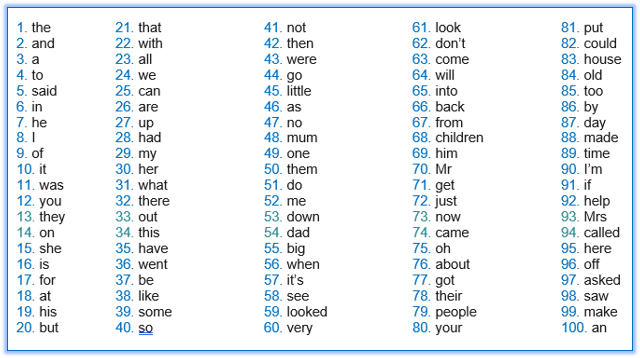
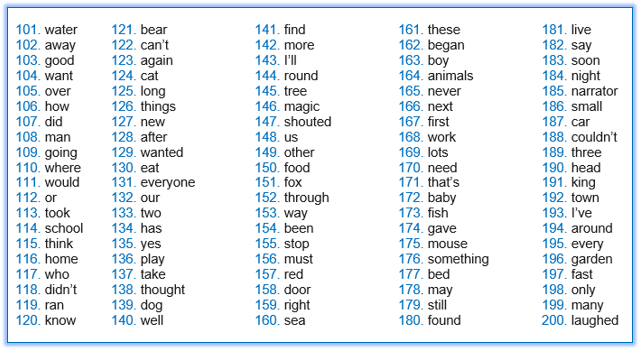
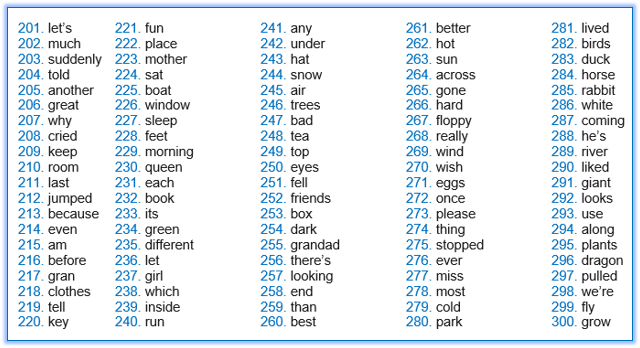
*Department for Education and Skills (2007), Letters and sounds: principles and practice of high-quality phonics. Tables from: Masterson, J., Stuart, M., Dixon, M. and Lovejoy, S. (2003) Children’s Printed Word Database: Economic and Social Research Council-funded project, R00023406
Several high-frequency word lists have been compiled by researchers over the years, and we discuss these in our sight words article. You can use the following link to access a list of the most common words in English compiled from the Oxford dictionary.
Are High-Frequency Words the Same as Sight Words?
The two terms are often used interchangeably, but definitions of sight words vary. Some people only class common irregular words as sight words, whereas others say that both regular and irregular words are sight words if they occur frequently in print. See our article on sight words for more information about this.
Why Teach High-Frequency Words?
It’s important that children become familiar with high-frequency words because they will encounter some of them in almost every sentence they read.
Researchers have estimated that around 65% of the words in a piece of text are likely to be in high-frequency word lists like the one we’ve printed above, although the exact percentage can vary depending on the type of text used.
If children can’t decode high-frequency words they will struggle to read and make sense of simple books. Children will also find writing basic sentences difficult if they can’t spell high-frequency words.
Are High-Frequency Words Decodable?
Some high-frequency words are easily decodable for beginning readers who have learned the simple alphabetic code. However, other high-frequency words require knowledge of the complex alphabetic code, so these wouldn’t be decodable for beginning readers.
For example, the words ‘dad’ and ‘got’ are examples of high-frequency words that could be decoded by youngsters with a basic knowledge of phonics. However, beginning readers would find the high-frequency words ‘there’ and ‘like’ more difficult to decode.
Nevertheless, most high-frequency words contain some letters with common letter-sound correspondences, so even children with a rudimentary knowledge of phonics can tackle these words with a little bit of help from an adult.
What are tricky words in Phonics?
Tricky words are words that children can find difficult to read because they contain spelling patterns that aren’t usually taught in the early stages of phonics instruction.
Children are normally introduced to the basic alphabetic code at the start of phonics instruction and this enables them to decode dozens of individual words.
However, there are many other words with letter-sound correspondences that aren’t taught in the basic code, so beginning readers find these tricky.
The short video below provides a simple explanation of tricky words:
The Jolly Phonics programme has used the term ‘tricky words’ for years and the video below shows examples of tricky words being discussed in lessons with beginning readers:
Some phonics programmes don’t use the term tricky words; they use alternative phrases for similar words such as sight words, red words, camera words, irregular words or common exception words.
Are High-Frequency Words and Tricky/Irregular Words the Same?
Sometimes, but not always. Some high-frequency words are tricky/irregular, but others follow the basic alphabetic code exactly, so can be described as regular words. Also, some tricky/irregular words don’t appear often enough in print to be described as high frequency.
For example:
- The words ‘the’ and ‘said’ have irregular spellings and they are used very frequently so they are high frequency and irregular/tricky words.
- The words ‘in’ and ‘at’ are high-frequency words but they have very regular spellings, so they are not tricky words.
- Words such as ‘crescendo’, ‘quay’ and ‘maestro’ have irregular spellings, so they are tricky, but they don’t appear very often in children’s literature, so they wouldn’t be classed as high-frequency words.
Back to contents…
What are some examples of tricky words?
Many tricky words are common/high-frequency words such as ‘the’, ‘to’, ‘what’, ‘said’ and ‘was’.
We’ve produced a common tricky/exception word list that contains over 200 words which you can download for free. The words have been collated from a variety of high-frequency word lists and they’re arranged in groups based on common spelling patterns, sounds or meanings (except for the last group of words which don’t share any obvious patterns).
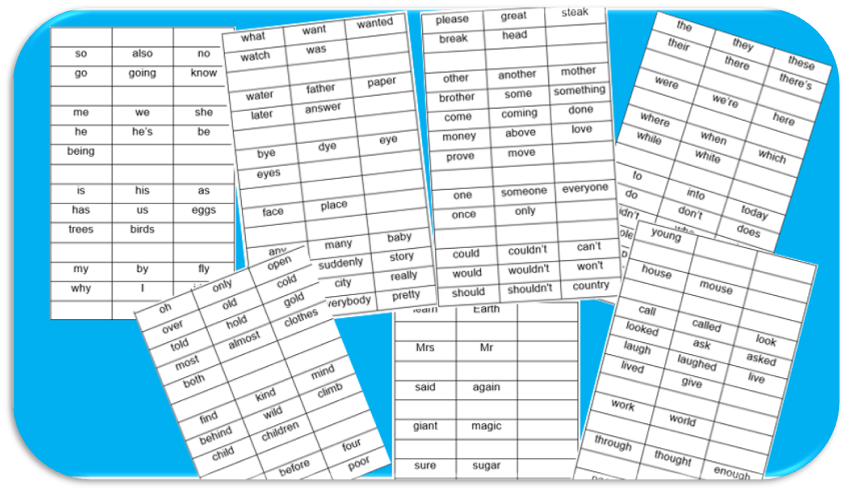
The information below shows the tricky words that are introduced in the different phonics phases that are commonly followed by schools in England.
Tricky Words in the Early Years Foundation Stage (EYFS)/Reception
Children in England start reception in the academic year they turn 5 years old. The phonics instruction is often split into 4 phases in line with the guidance in the government’s phonics programme, Letters and Sounds.
However, there is no compulsion for schools to follow these guidelines strictly and some schools will teach words in a different order in accordance with the phonics programme they are following.
Nevertheless, the tricky words shown in the Letters and Sounds phases below will be similar to those in many other phonics programmes.
Tricky Words in Phase 1:
Phase 1 is mostly concerned with improving children’s language, communication and listening skills. No written words are included in phase 1, although there is often some overlap with phase 2.
Tricky Words in Phase 2:
as, is, his, has, the, to, into, of, no, go, I
Tricky Words in Phase 3:
he, she, we, me, be, was, my, you, her, they, all, are
Tricky Words in Phase 4:
said, so, have, like, some, come, were, there, little, one, do, when, out, what
Tricky Words in Year 1/Phase 5:
oh, their, people, Mr, Mrs, looked, called, asked, water, where, who, again, though, work, mouse, many, laughed, because, different, any, eyes, friends, once, please
See also our list of common exception words in year 1.
Tricky Words in Year 2/Phase 6:
No specific examples for phase 6 were provided in the Letters and Sounds programme; the choice of words was left to the teacher’s discretion. However, the emphasis in this phase of the programme is on improving children’s spelling and so this phase would naturally include words that don’t follow the most common spelling patterns.
See also our list of common exception words in year 2.
As children progress in phonics they are introduced to more aspects of the advanced alphabetic code and, eventually, this allows them to decode almost all the words they encounter in age-appropriate books.
However, they are still likely to meet a few words with unusual spelling patterns occasionally.
What Are Common Exception Words in Phonics?
Common exception words are words that appear frequently in print but contain some letter-sound relationships that are not consistent with the basic alphabetic code that’s taught in early phonics instruction.
Beginning readers can find these words difficult to decode if they haven’t been taught the irregular spelling patterns in them.
The term ‘common exception words’ is used in the National Curriculum in England. The English programme of study spelling appendix 1 gives the following description:
“The ‘exception words’ contain GPCs which have not yet been taught as widely applicable, but this may be because they are applicable in very few age-appropriate words rather than because they are rare in English words in general.” (Page 1)
What this means in plain English is that some of the sounds in these words are represented by spelling patterns that the children aren’t familiar with.
This might be because the words contain rare or unusual letter-sound relationships or simply because the children just haven’t been taught those spelling patterns yet.
Are Common Exception Words the Same as Tricky Words?
The two phrases are often used to describe similar words, but ‘common exception words’ is a more precise term than ‘tricky words’ because it defines words that are both high frequency and irregular in their spelling patterns.
Labelling a word as tricky indicates that it’s difficult to read but it says nothing about how often the word is used in texts. For example, words such as ‘jeopardy’, ‘freight’ and ‘rheumatism’ would be tricky for beginning readers, but they are unlikely to appear in young children’s books. Consequently, these words wouldn’t be classed as common exception words.
The Department for Education in England used the phrase tricky words in their Letters and Sounds programme which was published in 2007; however, they have used the expression ‘common exception words’ in more recent publications.
Are Common Exception Words the Same as High-Frequency Words?
Not exactly, all common exception words are high frequency, but not all high-frequency words are common exception words.
For example, the words ‘to’ and ‘he’ are common exception words because they occur frequently in print, and they have spellings that are inconsistent with the basic alphabetic code.
However, the words ‘and’ and ‘can’ are high-frequency words but they have very regular spellings, so they wouldn’t be classed as common exception words.
The diagram below illustrates the relationships between common exception words, tricky words and high-frequency words…
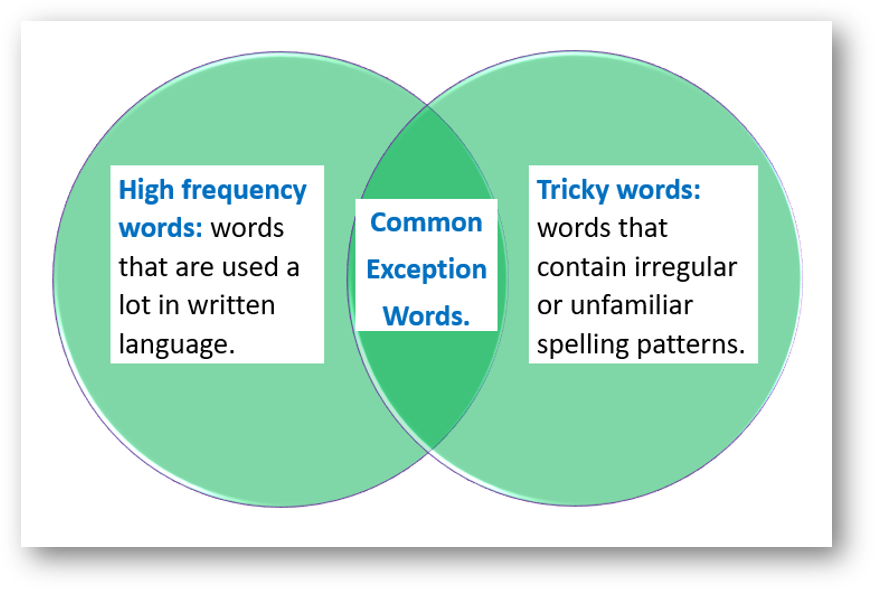
Note that there is no uniform definition of sight words. Some people use the phrase to mean the same thing as high-frequency words and others use it to mean the same thing as irregular/tricky/common exception words.
Are Common Exception Words Statutory?
Teaching common exception words is a statutory requirement in England but this might not be the case in other regions.
In England, the statutory framework for the early years foundation stage (effective from September 2021) mentions common exception words in the Early Learning Goals:
“Word Reading – Children at the expected level of development will:
– Read aloud simple sentences and books that are consistent with their phonic knowledge, including some common exception words.” (Page 13)
And the programme of study for primary schools in the English National Curriculum also makes it clear that common exception words need to be taught:
The section on word reading states (amongst other things):
“Pupils should be taught to:
- read common exception words, noting unusual correspondences between spelling and sound and where these occur in the word.”
Statutory Guidance National Curriculum in England: English Programmes of study.
The section on spelling also says that pupils should be taught to spell common exception words. However, there is no statutory requirement in the National Curriculum to teach a particular group of common exception words in years 1 and 2…
“The number, order and choice of exception words taught will vary according to the phonics programme being used.”
National curriculum in England: Key stage 1 – year 1 English programme of study. Reading notes and guidance.
It is also made clear in the English spelling appendix* that there is no statutory list of common exception words in years one and two. Example words are provided in the spelling appendix, but it states after the examples:
“- and/or others, according to the programme used.”
*English appendix 1: Spelling.
The spelling word lists for years 3 and 4 and years 5 and 6 are statutory in England.
Examples of Common Exception Words
In year 1, the words ‘by’ and ‘my’ are given as examples of common exception words. This is because the letter y in ‘by’ and ‘my’ represents the /igh/ (aɪ) sound that’s found in words like ‘fright’ or ‘fried’.
Up to this point, children will only have been taught that the letter y represents the sound found in words such as ‘yet’ or ‘yellow’.
In another year 1 exception word, said, the highlighted letters represent the same sound as the letter e in the words bed and jet. Children who have learned about digraphs will have been taught that the ‘ai’ letter combination normally represents the vowel sound /ai/ (eɪ) found in words such as train or snail.
The exception words included in the English National Curriculum in the UK are words that are used frequently in pupils’ writing (high-frequency words) which is why they are called common exception words. Children might be given a list of these words to learn in each year of primary school.
The examples below are the common exception words listed in the English programme of study spelling appendix published by the Department for Education in England.
Common Exception Words in Year 1
There are 45 examples of common exception words in year 1…
the, a, do, to, today, of, said, says, are, were, was, is, his, has, I, you, your, they, be, he, me, she, we, no, go, so, by, my, here, there, where, love, come, some, one, once, ask, friend, school, put, push, pull, full, house, our
– and/or others, according to the programme used.
Notes:
Regional accents can affect whether words are perceived as exceptions or not. For example, the words put, push, pull and full are listed as exceptions because the letter u in these words represents the /oo/ (ʊ) vowel sound that’s normally found in words like foot, look and book. It’s more common for the letter u to represent the /u/ (ʌ) sound that’s spoken in words such as cup, duck and butter.
However, in some parts of the north of England, the /u/ (ʌ) sound isn’t pronounced in any words, so put and but are spoken with the same /oo/ (ʊ) vowel sound and both words rhyme with foot.
Similarly, in the year 2 word list below, the words fast, last, past, class, grass, pass, plant, path and bath are exceptions in some southern English accents where the /ar/ (ɑ:) vowel sound is used, but they are not exceptions in other accents where the a in these words is pronounced (æ), as in cat.
Common Exception Words in Year 2
There are 64 examples of common exception words in year 2…
door, floor, poor, because, find, kind, mind, behind, child, children*, wild, climb, most, only, both, old, cold, gold, hold, told, every, everybody, even, great, break, steak, pretty, beautiful, after, fast, last, past, father, class, grass, pass, plant, path, bath, hour, move, prove, improve, sure, sugar, eye, could, should, would, who, whole, any, many, clothes, busy, people, water, again, half, money, Mr, Mrs, parents, Christmas
– and/or others according to the programme used.
Note: ‘children’ is not an exception to what has been taught so far but is included because of its relationship with child.
Common Exception Words in Reception
There are no examples of common exception words listed in the current statutory framework for the early years foundation stage, but many schools follow the guidelines set in the Letters and Sounds programme for tricky words. See ‘Tricky Words in the Early Years Foundation Stage (EYFS)/Reception’ in this article.
We’ve also produced a common tricky/exception word list that contains over 200 words that you can download for free. The words have been collated from a variety of high-frequency word lists and they’re arranged in groups based on common spelling patterns, sounds or meanings (except for the last group of words which don’t share any obvious patterns).
Teaching High-Frequency Words, Tricky Words and Common Exception Words
Deciding when and how to teach high-frequency words can depend on just how common the individual words are and the complexity of their spelling patterns.
Simple high-frequency words that follow the basic alphabetic code can be introduced as soon as children have learned the relevant letter-sound correspondences.
This can include some of the most common high-frequency words such as in, it, on, at, and, but, can, up, had, went, not, Mum/Mom, Dad, big, will, back, from, him, get, just, got, if, off and an.
There is no reason for children to learn words like these by rote because they all have very regular spelling patterns and children can be taught how to decode and blend them quite early in a phonics programme.
When to Introduce Tricky/Exception Words
Some phonics programmes introduce a few tricky words after children have been learning phonics for a few weeks. This is done to make it easier for them to read captions and whole sentences in children’s books.
For example, Jolly Phonics* recommend that teachers introduce around 2 tricky words/week after half the letter sounds have been taught.
*Lloyd, S. (2008) The Phonics Handbook, Jolly Learning Ltd.
John Walker, the founder of the Sounds-Write phonics programme, recommends a similar approach to teaching irregular high-frequency words.
The Letters and Sounds programme, published by the department for education in England, introduces a few tricky words in each phase of the programme. See our section on examples of tricky words for more information on this.
How to Teach Tricky/Common Exception Words in Phonics.
Some educators say that tricky/exception words should be learned as whole words by memorising their shapes. The argument is that they can’t be decoded using ‘normal’ phonics rules because they have irregular spelling patterns.
However, we think that trying to rote learn words by focussing on their outlines is unnecessary and unadvisable.
Alison Clarke has highlighted some of the problems of teaching ‘sight words’ this way in her ‘Spelfabet’ website and studies have demonstrated that children can read irregular words more successfully when they use phonics-based strategies.
This is because almost all ‘irregular’ words contain some letter-sound relationships that are taught in early phonics instruction. Also, brain and eye-tracking studies have shown conclusively that all words are recognised by the letters in them rather than their shapes.
The best strategy for teaching tricky words is to explain any unfamiliar spelling patterns while highlighting the sections in the words that are consistent with a child’s current phonics knowledge.
This strategy is in line with the advice from leading phonics programmes and the English programme of study for the National Curriculum in England:
“Phonic knowledge should continue to underpin spelling after key stage 1; teachers should still draw pupils’ attention to GPCs that do and do not fit in with what has been taught so far.”
*English appendix 1: Spelling
Research published by the International Literacy Association (ILA) drew similar conclusions. It said that teachers should encourage children to use graphophonemic analysis to read both regular and irregular high-frequency words, which basically means that children should pay attention to the letter-sound relationships in words.
This is the key principle that underpins phonics instruction and it was also one of the key ideas in the researchers 5 principles for teaching high-frequency words.
We elaborate on this strategy and some of the other key principles below…
For example, suppose a child gets stuck when they encounter the word ‘want’ in a passage they are trying to read to you.
Explain that this is a tricky word but encourage them to sound out the word first using their current phonics knowledge. It’s likely that they will sound out the letter a as if it represents the same sound as it does in words such as ‘cat’ or ‘Dad’.
They should realise straight away that it doesn’t sound like a real word if they use this vowel sound. Tell them what the word really sounds like and explain that the letter a doesn’t stand for its normal sound in this word – so, the letter a is the tricky part of the word.
want
Explain to your children that if a word doesn’t sound right when they read it they should try alternative pronunciations for some of the letters. But remind them that sometimes they might actually be saying a word correctly, and it may only sound odd because it’s unfamiliar to them.
Teaching words in groups that have similar spelling patterns is another principle outlined by the researchers in the ILA article we mentioned above.
For the tricky word example we used earlier (want) you could look at other words where the letter a represents the same sound. For instance, wasp and watch are similar to want in this respect.
The ILA article gives the example of teaching the words some, come, above and love together, but the idea can also be effective for extremely irregular words such as ‘one’, ‘eye’ and ‘two’.
Very few spelling patterns are completely unique. For example, ‘once’ is similar to ‘one’, and ‘bye’ and ‘dye’ have a similar pattern to ‘eye’.
And there can sometimes be relationships in meaning even when the words don’t share similar sounds. For example, ‘twin’, ‘twice’ and twenty have a similar meaning and spelling pattern to the irregular word ‘two’.
If you point these patterns out to a child, they are more likely to remember how to read and spell the words correctly.
See our free common tricky/exception words list for more examples of groups of words with similar spelling patterns.
Another principle is to practice reading tricky/exception words in sentences and books.
Although it’s useful to analyse tricky/exception words individually, and in groups with similar spelling patterns (as we’ve discussed above), children also benefit from encountering them within the context of sentences and books. This helps them to see the relevance of the words they are learning.
However, even relatively simple children’s books can contain a lot of irregular words, so beginning readers often need some adult support to help them read and fully understand these books. Support could be provided by a teacher reading a book with a whole class or by another adult carer reading a book one-to-one with a child.
‘Decodable’ phonics books can help because these are specifically written to have a limited number of irregular words in them. Unfortunately, this can also lead to limited storylines in some cases so it’s best to expose kids to a mix of different books to maintain their enthusiasm for reading. We discuss the best books for beginning readers more fully in a separate article.
Whatever type of book you are reading with a child, point out the tricky bits in words as you come across them, but only do this intermittently. If you overdo it, you could spoil the flow of the story.
Ultimately, we want to motivate children to read books independently for pleasure, so it’s as important for children to enjoy reading sessions with an adult as it is for them to pick up new skills.
So, when you encounter a tricky word, it’s OK to just tell the child what the word says and then move on. You might want to go over some of the words in more detail, and it’s fine to do this occasionally, but it might be better to wait until the end of a chapter or the end of a short book before you do this.
Over time, as children read more widely, they can actually start to figure out some of the irregular words themselves. This ‘self-learning’ is sometimes done subconsciously as their vocabulary grows and their brains respond to statistical patterns from words they’ve encountered previously. However, most children still need input from an adult occasionally, even when they’ve been reading for several years.
The special case of ‘the’…
The word ‘the’ is the most frequently used word in the English language, so beginning readers are likely to encounter this quite often in almost every piece of text they are exposed to.
Contrary to what some people believe, this word is quite regular for anyone who has learned about digraphs and the schwa sound. However, these ideas aren’t taught in the early stages of phonics instruction, and none of the letters in the word follow the letter-sound correspondences taught in the basic alphabetic code. So ‘the’ appears to be very irregular for beginning readers.
Consequently, in this case, it’s best to just tell children what the word says in the early stages, without elaborating on the details. Later, when you start teaching digraphs, you can point out the similarities it shares with outer words such as ‘this’, ‘that’ and ‘them’.
And you can also explain the pronunciation of the letter e in ‘the’ when you are teaching about the schwa sound.
Captions and Activities Containing Tricky/Common Exception Words…
As well as looking at tricky words in books, another option is to look at simple sentences and captions that have been prepared beforehand to highlight some specific words. Captions can provide a bridge between reading individual words and reading books.
We’ve collated some example captions like the ones below and you can download them all as a separate document by clicking on the following link for our free tricky/common exception word captions.
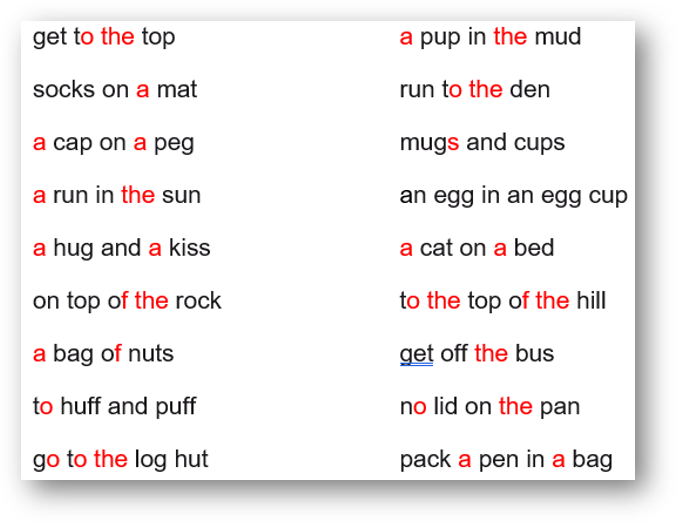 | 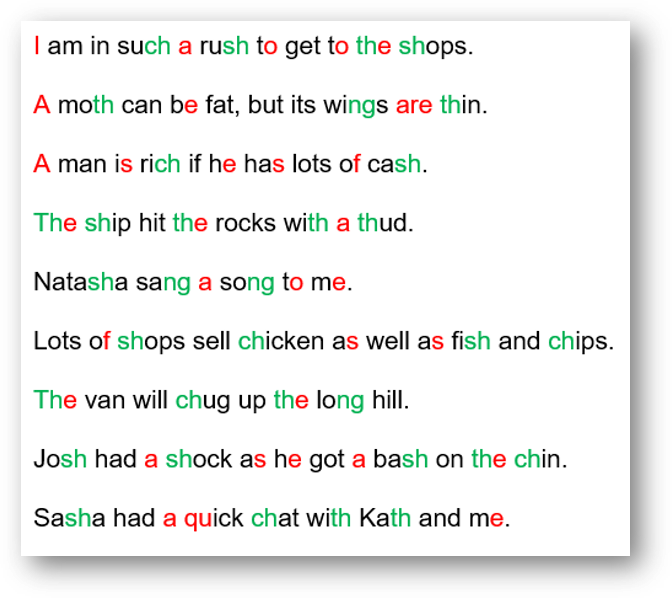 |
These captions were originally published in the UK government’s Letters and Sounds programme, but we’ve highlighted some of the tricky/exception spellings in them for your convenience. The document also contains unhighlighted versions of the captions.
In addition to the captions, the document contains a sentence substitution activity and some yes/no questions.
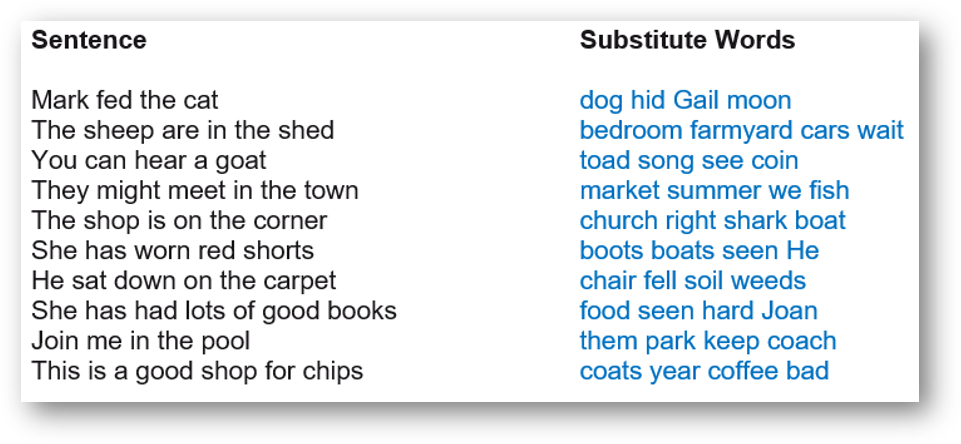
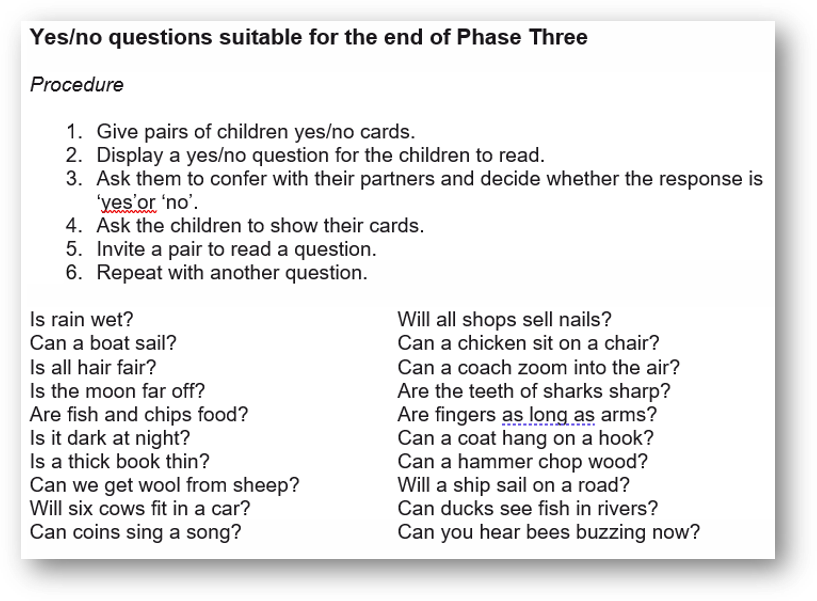
You might also want to check out our free tricky/common exception words worksheet which is also available as a PowerPoint slide show.
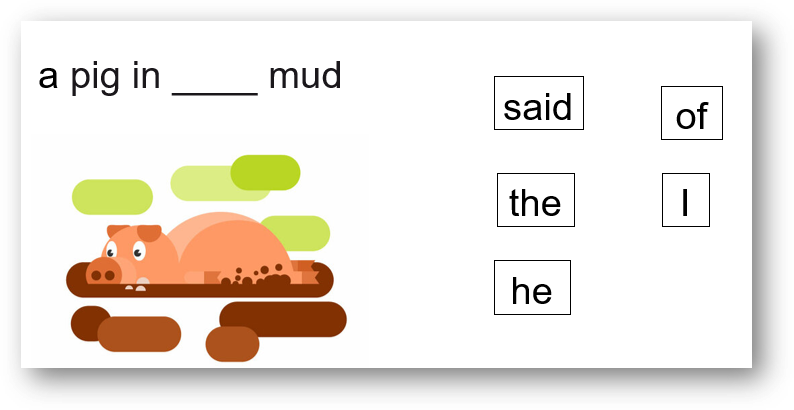 | 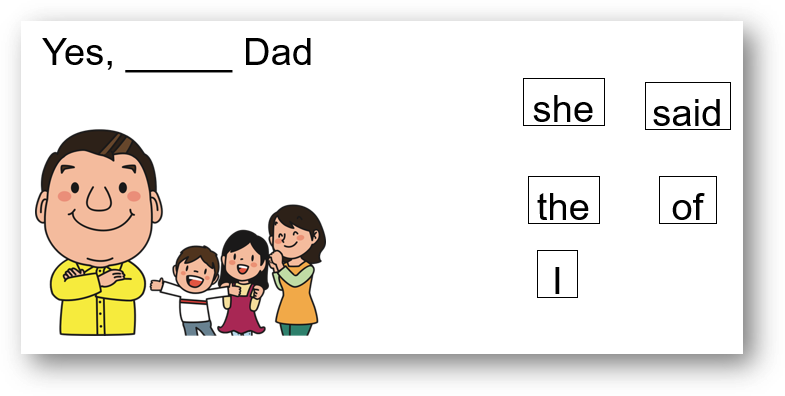 |
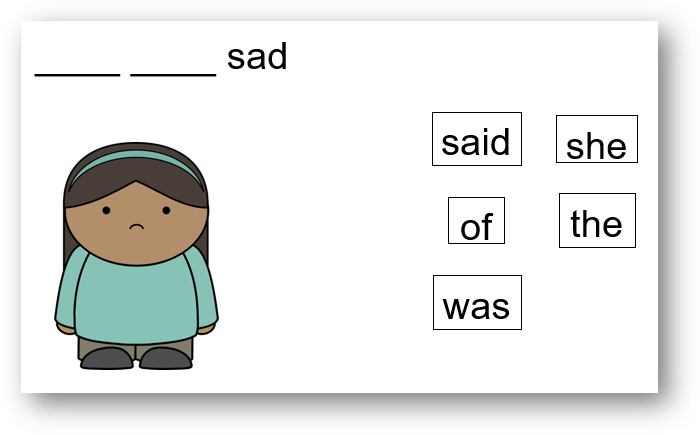 | 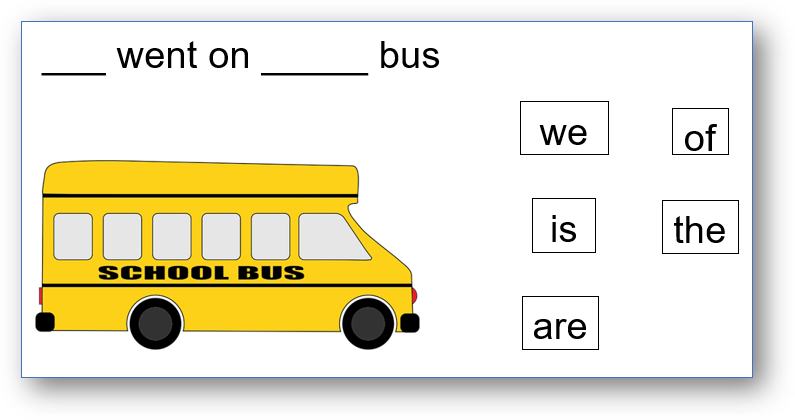 |
Children look at each picture and then choose the most suitable tricky/common exception words to complete each caption or sentence. The answers can be written in or it could be done as a cut and stick exercise. You could also click and drag the text boxes in the PowerPoint version.
Tricky Words Games
Some teachers use games to provide variety when they are teaching tricky/common exception words. Phonics teacher Miss Barrie shares some simple games to help children learn tricky words in the video below…
See also our compilation of Free High-Frequency Words/Sight Words and Tricky/Common Exception Words Online Games. These games include a mixture of regular high-frequency words and irregular/tricky/common exception words.
Spelling Tricky/Common Exception Words
We provide tips for teaching children to spell tricky words in one of our spelling articles.